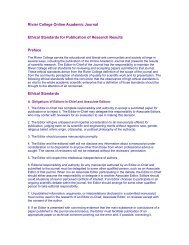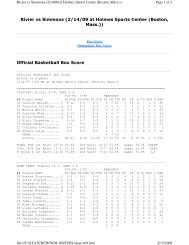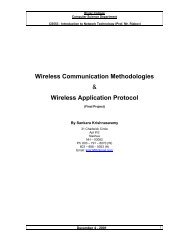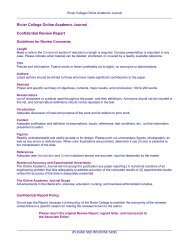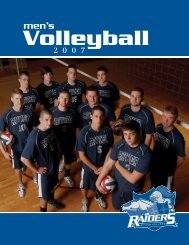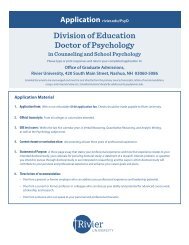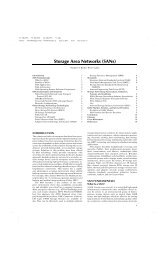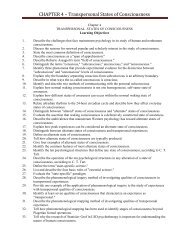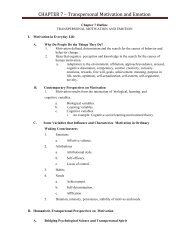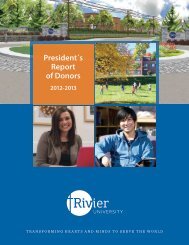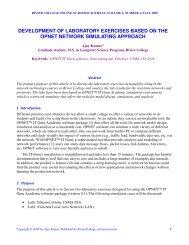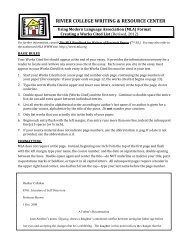Nursing 203 Database
Nursing 203 Database
Nursing 203 Database
Create successful ePaper yourself
Turn your PDF publications into a flip-book with our unique Google optimized e-Paper software.
Rivier College<br />
Division of <strong>Nursing</strong><br />
Associate of Science Degree Program in <strong>Nursing</strong><br />
NSG <strong>203</strong> - Care of the Adult II<br />
Patient Data Base<br />
Student Name Clinical Date(s): 1/25/07 – 1/26/07<br />
DEMOGRAPHICS DATA/MEDICATION HISTORY<br />
Gender M Age 89yo Admission Date 1/24/07 @<br />
7:50<br />
Primary Language English Other Language No Name Band<br />
On Yes<br />
Advanced Directives: YES x NO If no, information provided? YES NO If<br />
no, explain:<br />
DNR &<br />
DNI<br />
Admitting Diagnoses:<br />
Anemia<br />
Explanation of Pathophysiology of Medical Diagnoses (list source):<br />
Anemia is a condition in which the RBC count and the hemoglobin (Hgb) levels are lower than normal. Because of<br />
this, there is a less amount of O 2 being transported to the body’s tissues. RBCs contain hemoglobin, which carries O 2<br />
from the lungs to all of the body’s muscles and organs. Oxygen is necessary for energy which is needed for the cells of<br />
the body to function efficiently. There are many forms of anemia. It can be caused by blood loss, diseases, medication<br />
effects, poor diet, and vitamin or Fe deficiencies. This particular patient condition and lab results were being<br />
researched. It was believed the patient was experiencing a blood loss related to internal<br />
bleeding.<br />
(http://www.mayoclinic.com/health/DiseasesIndex/) and<br />
(www.anemia.com)<br />
Name of Surgical Procedure (if applicable)<br />
N/A<br />
Date of Surgery: N/A This patient’s<br />
N/A<br />
(#) postoperative day.<br />
Brief description of surgical procedure N/A<br />
Past Health History (Include all previous and existing diagnoses with explanation, surgeries, accidents,<br />
fractures, hospitalizations and their dates.)<br />
Non-Q wave MI 1/8/07: when myocardial tissue becomes necrotic because of absent or diminished blood supply. Pain<br />
develops form irritation of nerve endings in the ischemic and injured areas. Partial thickness (of the ventricular wall)<br />
also called non-Q waves, are characterized by ST-T wave changes but no abnormal Q waves.<br />
Glaucoma: An acute or chronic condition in which there is an of intraocular pressure (IOP) which leads to (tissue<br />
damage) damage from compromised blood flow of retina and optic nerve = visual field loss.
CHF: Inadequacy of the heart so that as a pump it fails to maintain the circulation of blood, with the result that<br />
congestion and edema develop in the tissues. ↓ cardiac output r/t impaired cardiac function. Excess fluid volume r/t<br />
impaired excretion of Na and H 2O. workload of heart with HTN.<br />
Atelectasis: collapse of lung tissue r/t airway obstruction, an abnormal breathing pattern, or compression of the lung<br />
tissue( s/a: from a tumor, pleural effusion or pneumothorax. Other causes are mucous plugs in pts. who smoke heavily<br />
and inflammation from inflammatory lung disease. Cigarette smoking causes arterial vasoconstriction and plaque<br />
formation. Also cholesterol atherosclerosis.<br />
CVHD: cardiovascular Heart disease r/t heart and blood vessels, pulmonary embolism: r/t detached fragments of<br />
thrombus from a leg<br />
HTN: Persistent or intermittent elevation of systolic arterial blood pressure > 140mm HG or diastolic pressure >90 (3<br />
readings > 140/90) cause unknown but r/t risk factors s/a: genetics, stress, obesity, Na diet & vascular disorders. work<br />
load of heart with HTN.<br />
Hyperlipidemia: an elevated level of lipids (fats) in the<br />
blood<br />
left side pleural effusion: amounts of fluid with in the pleural cavity, usually r/t inflammation.<br />
TURP: tumors on bladder (transurethral resection of the prostate): inserting a resectoscope through the urethra.<br />
Hypertropic tissue is cut away, ∴ relieving pressure on the urethra. Enlarged prostate: related tumors on<br />
bladder.<br />
Alcohol Use, on-going smoker: 1 pack/day for 65 years. Alcohol is a primary and continuous depressant of the CNS.<br />
Depresses leukocytes movement to inflamed areas. ↓platelet functions and leads to fibrinogen and clotting factor<br />
deficiency.<br />
Family History (Include age and state of health of all members of immediate family - mother, father,<br />
siblings. If deceased, age, year of death and cause of death)<br />
mother deceased age: 68yo year of death: 1948 cause of death:<br />
does not know<br />
father deceased age: 75yo year of death: 1954 cause of death:<br />
pneumonia<br />
sister deceased age: 94yo year of death: 1994 cause of death:<br />
does not know<br />
Also Taken @ home:<br />
Aspirin 325mg 1tab daily AM<br />
Warfarin 4mg 1 tab daily PM<br />
Medications (attach an additional sheet if necessary)<br />
Drug Name OTC or Taken @<br />
Home<br />
Ordered in Hospital Reason Taken<br />
Patient Need<br />
Patient’s explanation<br />
for Medication<br />
Ambien 10mg PRN PO HS Induction of sleep Pt. did not know what<br />
Tylenol 650mg q 4° PRN h/a and pain his medications are<br />
PO<br />
Zofran 0.4mg q 6° PRN IV nausea for. However, pt.<br />
Vit K 10mg SQ x1 Aid in blood clotting states that he thinks<br />
Imdur<br />
Taken @ Home but<br />
30mg/qd<br />
60mg q day PO antianginal they are mostly for<br />
Lisinopril Taken @ Home 20mg q day PO Anti hypertensive high blood pressure.<br />
Lipitor Taken @ Home 80mg q day PO To lower cholesterol<br />
Bisoprolol Taken @ Home 10mg q day PO Anti hypertensive<br />
Clonidine Taken @ Home 0.1mg 2x/day PO Anti hypertensive<br />
Furosemide (lasix) Taken @ Home 40mg q AM PO Edema<br />
Nitroglycerin Taken @ Home .4mg S/L q 5min<br />
PRN<br />
For chest pain<br />
HEALTH PERCEPTION/HEALTH MANAGEMENT<br />
Patient’s perception of general health:<br />
every morning<br />
“I feel good on 6 hours of sleep since I was in the service. I get up
around 5 am, take a shower, and get dressed every day. I feel pretty good every day. At 86 years old,<br />
everything went to hell, right after my first heart attack.”<br />
Health practices and effects: (list frequency, amount, type, duration, and length of time since quitting.)<br />
• Physical Exercise: walks daily about 2 miles, and it takes about an hour or<br />
two.<br />
• Smoking: smoked for 65 years. Just quit two weeks ago, after a heart attack. He smoked 1<br />
pack/day.<br />
• Caffeine: Dependent on coffee. About 6-8 cups/day with cream or milk and no<br />
sugar.<br />
• Alcohol: socially. “I have an occasional<br />
drink”<br />
• Recreational Drugs:<br />
no<br />
• Frequency of health checkups: “only when I feel like it and I have<br />
to.”<br />
• Breast/Testicular Self exam: no<br />
Frequency:<br />
• Seat Belts: Yes. He no longer<br />
drives.<br />
• Dental Care: Patient has dentures. When he was in the service he had his teeth pulled. Only goes<br />
when there is a problem.<br />
Ability to follow care plan, knowledge of health practices:<br />
of health practices.<br />
Yes, patient is aware and is knowledgeable<br />
Allergies Prednisone<br />
Symptoms/ treatment: pruritis &<br />
rash He is not sure of the treatment. It happened many, many years ago when he was in the service.<br />
Health Insurance: Yes x No<br />
Tricare: for being in the service for more than 20 years. Whatever they don’t pay,<br />
Medicare will pay the rest. (100% covered)<br />
Do you feel safe?<br />
Yes<br />
Potential<br />
<strong>Nursing</strong> Diagnoses: Knowledge Deficient r/t patients lack of knowledge of his own health issues aeb<br />
not knowing what medications he is taking and what they treat, smoking for 65 years but recently stopped<br />
after a MI, intake of a substantial amount of caffeine daily, no consistent and frequent and preventative<br />
health checkups, visits the doctor “when I feel like it and I have to”, he does not perform testicular self<br />
exams, he does not know the treatment he was given to an allergic reaction to Prednisone and insufficient<br />
knowledge regarding care of his diseases (HTN= ↓ Na intake)
Laboratory Test (attach an additional sheet if<br />
necessary)<br />
Date Pt. Value<br />
Normal Range What do you do<br />
because of this<br />
result?<br />
What diagnosis does<br />
this value relate to?<br />
1/25/07 6am<br />
WBC 9.9 5-10 x10 9<br />
RBC 2.96 (L) 4.7-6.1 x 10 units of RBC Anemia- internal bleed<br />
Hgb 8.7 (L) 14-18g/dL RBC units & O 2 anemia<br />
Hct 23.8 (L) 42-52% units of plasma Blood loss anemia<br />
Pt 120 (H) 10.5 - 13.1 Vitamin K Anemia:internal bleed<br />
PTT/INR 12.9 (C&) 0.9-1.1 Vitamin K Anemia:internal bleed<br />
Electrolytes<br />
Na 137 135-145<br />
K 4.1 3.5-5.0<br />
Cl 105 98-106<br />
Bl. Glucose 106 80-120<br />
BUN 44 (H) 10-20 Renal Failure<br />
CREATINE 1.4 (H) 0.6-1.2 Renal Failure<br />
D-dimer test<br />
SGPT 22 4-36 u<br />
SGOT 22 0-35 u<br />
platelets 330 150-400 x 10 9 /L<br />
lymphocytes 16.6 (L) 5-10 x 10 9 /L Vitamin K /<br />
Blood<br />
Anemic-internal bleed<br />
albumin 2.1 (L) 3.5-5.0 protein intake PO Alcohol use/ Diet:<br />
nutritional deficiency<br />
Ca 7.8 (L) 9-10.5 Ca/vit D intake Alcohol use/ Diet:<br />
nutritional deficiency<br />
MI, rxt. to plasma ?<br />
Triponin-1 0.4 (H) < 0.03 ng/ml Stop plasma,<br />
telemetry<br />
EKG STAT<br />
protein 4.6 (L) 6.4-8.3 protein intake PO Alcohol use/ Diet:<br />
nutritional deficiency<br />
Anemic<br />
neutrophils 73.2 (H) 55-70 Blood, monitor:<br />
good nutrition,<br />
fluids, rest<br />
monocytes 10 (H) 2-8 Monitor: good Anemic::mono?Second-ary<br />
nutrition, rest fluids. to dehydration.<br />
UA/Urine RBC 1/24/07 7.7 (H) small<br />
bleeding in urine<br />
Up to 2 Monitor urine,<br />
address Pt<br />
Anemic-internal bleed.<br />
Alcohol use<br />
C&S 1/24/07 + guaiac (-) No occult<br />
blood within<br />
stool<br />
&PTINR<br />
Monitor urine,<br />
address Pt<br />
&PTINR<br />
1/25/07 + guaiac Monitor urine,<br />
address Pt<br />
&PTINR<br />
Anemic- internal<br />
bleed<br />
Diagnostic Tests: Include Radiograph, EKG, EEG, Biopsy, Etc.…<br />
Test/Procedure Client Results Nsg. Safety Measures<br />
Taken<br />
How does this relate to<br />
Diagnosis<br />
Telemetry: (5 leads) No: to detect/Id abnormal Anemia can cause the heart to
CXR:BNP (lab for measure<br />
% of CHF)<br />
Venous diplex<br />
EKG: A graphic<br />
representation of the<br />
electrical impulses that the<br />
heart generates during the<br />
cardiac cycle.<br />
EKG STAT<br />
heart rhythms and to diagnose<br />
acute myocardial infarction,<br />
conduction defects and<br />
ventricular hypertrophy. Note:<br />
an EKG can be normal even<br />
in the presence of a heart<br />
attack.<br />
The EKG did not show<br />
anything of concern.<br />
CXR: lungs unchanged, no<br />
significant interval change<br />
Stopped plasma IV : STAT<br />
Telemetry, V/S<br />
pump harder to compensate<br />
for low RBC and hemoglobin<br />
and therefore can cause MI.<br />
Pt. experienced a rare allergic<br />
reaction to plasma= chest pain<br />
and an EKG ordered stat to<br />
see if any irregular electrical<br />
impulses.<br />
Activity<br />
Exercise<br />
Patterns<br />
:<br />
Code Level 0: Independent<br />
Level 1: Requires use of device (specify)<br />
Level 2: Requires help of a person<br />
Level 3:<br />
Requires help of a person and<br />
device<br />
Level 4:<br />
Dependent (objective) patient<br />
exhibits<br />
Subjective: Prior to Admissions (Patient Reports)<br />
Objective: At Present<br />
(Patient Exhibits)<br />
Functional Level<br />
0 Eating 0: breakfast, lunch and drinks<br />
0 Hygiene 0: pt. shaves, washes dentures, cleans<br />
self<br />
0 Dressing 0: pt. dressed into own clothes<br />
0 Toileting 0: pt. urinates in urinal, BM in toilet<br />
0 Ambulation 0: pt. walks to BR and around room<br />
0 Home Maintenance 0: pt. charges electric shaver,<br />
SUBJECTIVE: (PATIENT REPORTS)<br />
OBJECTIVE: (PATIENT EXHIBITS)<br />
Gait<br />
normal<br />
Assistive Devices______no_________________________<br />
________________________________________________<br />
_<br />
History of Falls_________no______________________<br />
________________________________________________<br />
_<br />
Symptoms related to Activity (chest pain, difficulty<br />
Falls in Hospital no<br />
Joint Appearance ankles, edema +1<br />
ROM full limited absent<br />
RA x<br />
LA x<br />
RL x<br />
LL x<br />
SAFETY NEEDS no
eathing, leg or arm pain, joint or muscle pain, fatigue,<br />
palpitations)<br />
Temperature 35.6 C° Route oral<br />
No. He does not know what caused his chest pain. He was<br />
not doing any activities that linked to his chest pain. He does<br />
not push himself.<br />
Physical Exercise habits: He walks daily, about 2 miles/day<br />
________________________________________________<br />
_<br />
Safety Needs: No<br />
Pulses:<br />
Apical 63 Rate normal Rhythm normal<br />
Carotid 60 Present x Absent<br />
Radial 64 Rate normal Rhythm normal<br />
Pedal Present x Absent<br />
Quality of Pulses:<br />
strong and defined.<br />
CRT R Hand 3 sec L Hand 3 sec<br />
R Foot 3 sec L Foot 3 sec
SUBJECTIVE (PATIENT REPORTS)<br />
Dizziness yes no x<br />
Shortness of breath yes no x<br />
When? N/A<br />
Cough sometimes first in the morning<br />
Sputum Production spits a little into a tissue<br />
Color change with 0 2 yes no x<br />
OBJECTIVE (PATIENT EXHIBITS)<br />
BR:<br />
L<br />
R<br />
ORTHO STATIC BP<br />
Sit<br />
Stand<br />
Lay Down<br />
RESP: Rate normal + Depth<br />
normal +<br />
unlabored<br />
symmetrical<br />
Rhythm normal<br />
Symmetry normal<br />
Cough no<br />
Lung Sounds (describe) both days<br />
lung sounds are<br />
clear.<br />
(1/25/07: Pt is on 2L O 2 Nasal cannula.)<br />
Oxygen/Oximetry 0 2Rate_2L_ Delivery<br />
System_NC___<br />
0 2 Sat_99%_<br />
Potential <strong>Nursing</strong> Diagnoses: At risk for falls r/t physiological presence of an illness, anemia, that can<br />
potentially cause weakness, fatigue, confusion, tiredness, impaired balance, orthostatic Bp aeb patient on<br />
presently 2Lof oxygen and may experience signs/symptoms of anemia when taken off oxygen, also blood<br />
lab results indicate low RBC, Hgb and Hct also physical equipment s/a: extra long oxygen tubing, IV(for<br />
blood).<br />
Nutrition/Metabolic<br />
SUBJECTIVE: (PATIENT REPORTS)<br />
OBJECTIVE (PATIENT EXHIBITS)<br />
Diet in Hospital (Include Supplements)<br />
cardiac diet<br />
Typical food intake at<br />
home<br />
Height 5’7”<br />
Weight<br />
58.70 kg or 129.14 lbs.<br />
Food<br />
Fluid<br />
Morning<br />
cereal,<br />
Ideal Weight 148<br />
% over or underweight underweight= 13%<br />
Rationale for diet order r/t CHF, hyperlipidema, edema, CVHD<br />
MI.
toast<br />
coffee (3cups)<br />
OJ 1 cup<br />
Noon<br />
sandwich, any type<br />
Mostly cold cuts Coffee<br />
Evening Big dinners, mostly<br />
Meat and potatoes Coffee<br />
Snacks very seldom<br />
Coffee-7cups/day<br />
Problems with eating, drinking, digesting<br />
Usually no problems at all. But since heart attack two weeks ago,<br />
he has not had much of an appetite.<br />
enteral feedings (type, amount, strength, intermittent, continuo<br />
N/A<br />
NG tube: yes no x residual<br />
NG to suction yes no N/A<br />
Describe drainage N/A<br />
Food preferences not picky at all. Like all types of foods.<br />
Prescribed diet eats anything.<br />
Problems with healing no<br />
OBJECTIVE (PATIENT EXHIBITS)<br />
Description of teeth and oral cavity: The pt. has dentures.<br />
Oral cavity pink, intact and moist. Lips very dry.<br />
Condition of nails: very dry. Clean and groomed<br />
Skin condition: very dry. Especially the legs, hands and top of<br />
head.<br />
Skin color WNL Temperature warm<br />
Moisture dry Turgor poor<br />
SUBJECTIVE: (PATIENT REPORTS)<br />
WOUNDS:<br />
N/A<br />
Nutritional status fine, I usually eat well except for the last couple<br />
of weeks, since my MI<br />
Recent weight gain/loss? Yes, I used to weigh 185lbs. I have not<br />
been eating a lot since my heart attack. Lost weight in the last two<br />
months, especially the last two weeks.<br />
Color<br />
Edges<br />
Drainage<br />
Temperature<br />
Changes in appetite?<br />
times. No desire.<br />
Yes, does not feel like eating a lot of<br />
Sutures/Staples<br />
Edema yes no<br />
DSG Type<br />
Frequency<br />
FLUID/ELECTROLYTE THERAPY<br />
Venous access: yes Saline lock yes (at times)<br />
Site:L forearm:peripheral Date inserted 1/25/07(from R arm)<br />
Inspection of site: dry yes Intact yes<br />
Red no Swelling no Pain no<br />
Ecchymosis yes on both Temp warm<br />
Arms and ears<br />
IV Solution: 0.9% NaCl 20gL for arm (1/24/07)<br />
Rationale for use<br />
KVO
Medication added to IV zofran for nausea q 6° PRN<br />
Gravity drip no Pump yes Dial-a-flow no<br />
Gtts/min<br />
Hourly rate<br />
Potential <strong>Nursing</strong> Diagnosis : Imbalanced nutrition: less than body requirements r/t eating habits aeb<br />
underweight 13%, blood work electrolytes, labs indicate low calcium, albumin, and protein, eats a big meal<br />
at night, eats any types of foods, not a well balanced diet, sometimes lack of interest in food and has<br />
hyperlipidemia.<br />
Elimination<br />
SUBJECTIVE: (PATIENT REPORTS)<br />
BOWEL:<br />
OBJECTIVE: (PATIENT EXHIBITS)<br />
BOWEL:<br />
Frequency (usual)<br />
Character<br />
Control<br />
1 q AM<br />
normal<br />
yes<br />
Frequency 0 Last BM 1/26/07 Pt. has BM<br />
After OJ, coffee, and prune juice.<br />
Character hard, odor Color black<br />
Incontinence yes no x<br />
Discomfort<br />
no<br />
Diarrhea/Constipation<br />
no, however hard<br />
Use of laxatives, enemas, stool softener, fiber in diet<br />
Very seldom. Will use prune juice if no BM in 2-3 days.<br />
Discomfort<br />
no<br />
Bowel regimen ordered<br />
no<br />
Change in bowel pattern? Just since in the hospital. Has not<br />
been able to have a BM since 2 days ago.<br />
Bowel diversion (colostomy, ileostomy, etc.)<br />
ABDOMINAL ASSESSMENT<br />
Appearance: soft x flat x round rigid<br />
no<br />
Distended no Girth (# inches)<br />
Bowel sounds yes. Active bowel sounds x 4<br />
Tenderness<br />
no<br />
URINE:<br />
Frequency 4-5x/day Color yellow<br />
Clarity clear Discomfort no<br />
Control<br />
yes<br />
Change in urinary pattern? no<br />
URINE:<br />
Frequency 1x by 8:00am Color yellow<br />
Clarity clear Discomfort no<br />
Control yes<br />
Urinary diversions: no<br />
Foley no Date inserted N/A<br />
Type<br />
N/A
Intake 7 hr shift Past 24 hr Output 7 hr shift Past 24 hr<br />
PO 920ml + 360ml 2560ml Urine 200 ml + 4 indep.1440 + indep.<br />
IV Liquid Stool no<br />
Nasogastric no Drainage no<br />
Tube<br />
Other Blood no<br />
Other no<br />
Totals 1280 ml 2560 ml Totals 200ml + 4 indep. 1440+ indep.<br />
Potential <strong>Nursing</strong> Diagnosis Effective bowel and urinary pattern r/t usual and controlled<br />
urine/bowel routine aeb urinary frequency, clear clarity, yellow color, continence, no discomfort, having a<br />
BM, no distended abdomen, active bowel sounds in all four quadrants, no diarrhea, and no constipation.<br />
Sleep Rest Patterns<br />
SUBJECTIVE (PATIENT REPORTS)<br />
Usual sleep pattern 1100 pm – 5:00<br />
am<br />
Number of hours of sleep/24<br />
6/24<br />
Problems with sleep<br />
no<br />
C/O of drowsiness /fatigue:<br />
no<br />
Difficulty falling asleep<br />
no<br />
Difficulty remaining asleep no,<br />
Sleep aids<br />
no<br />
Means of relaxation<br />
radio<br />
listens to the<br />
OBJECTIVE (PATIENT EXHIBITS)<br />
Sleep pattern in hospital 1000pm – 5<br />
am<br />
Number of hours of sleep/24 7/24 with<br />
interruptions<br />
Changes in behavior: was having vivid<br />
nightmares<br />
Irritability<br />
no<br />
Lethargy<br />
no<br />
Listless<br />
no<br />
Restless yes. Ambien may have caused<br />
nightmares<br />
He thought he was in many different wars. Yelling to<br />
get his gun and walking down the<br />
hall.<br />
Difficulty falling/staying asleep difficulty staying<br />
asleep<br />
Napping during the day yes. One<br />
(10min)<br />
Physical changes:<br />
no<br />
Dark circles under eyes<br />
no<br />
Yawning<br />
no<br />
Expressionless face<br />
no<br />
Potential <strong>Nursing</strong> Diagnosis: Effective sleeping pattern r/t usual sleep routine aeb 6-7 hours/night,<br />
waking rested, up and active early morning, no dark circles under eyes, no yawning, or behaviors related to<br />
a poor nights sleep.
Cognitive/Perceptual<br />
SUBJECTIVE (PATIENT REPORTS)<br />
OBJECTIVE (PATIENT EXHIBITS)<br />
Ability to speak/comprehend<br />
yes<br />
Glasses<br />
yes<br />
Hearing aid<br />
no<br />
Other<br />
Dentures<br />
Dizziness/vertigo<br />
no<br />
Sensory smell<br />
yes<br />
Taste<br />
__________yes________________________<br />
Tingling, numbness<br />
no<br />
Alteration in feeling<br />
no<br />
Pain: no<br />
Site N/A<br />
Radiation N/A<br />
Duration: N/A<br />
What increases pain<br />
know<br />
What measures decrease pain<br />
nitroglycerin X3<br />
I do not<br />
Intensity (0-5 or 0-10) Yesterday, pain<br />
was a 1 after 3 nitroglycerin pills. I have no<br />
pain now. I do not know why I had chest<br />
pain. I was not doing anything that would<br />
cause it.<br />
LOC (alert, lethargic, comatose) Alert<br />
Orientation<br />
X3<br />
Speech pattern: normal pattern, structure, and<br />
volume<br />
Clarity<br />
clear<br />
Logical flow yes<br />
Dysphasia no<br />
Eyes open, clear, no external physical obstruction<br />
PERRLA present, normal<br />
Ears normal<br />
Ability to see, hear, smell: glaucoma, legally blind<br />
Posture straight, normal<br />
Paresthesia/paralysis no<br />
Observed compliance with health care regimen.<br />
Yes . sits in chair, baths, performs hygiene, uses urinal, uses hat in<br />
toilet for BM, takes prune juice to promote BM<br />
Pain:<br />
Facial Expression: no Change in VS? __no_______<br />
Acute no Chronic no both<br />
Self Perception/Self Concept Pattern<br />
SUBJECTIVE (PATIENT REPORTS)<br />
OBJECTIVE (PATIENT EXHIBITS)<br />
Occupation (if retired, former job)<br />
Self description He was in the US military, Army branch. Posture sitting, straight and comfortably in chair
Also was a selectman, budget committee chairman, policeman<br />
Effect of illness/surgery on self concept<br />
I wish I wasn’t in here. I wish they knew what was wrong<br />
with me.<br />
Facial expression smiles when talking of past. Concerned l<br />
when talking of illness.<br />
Eye contact looks into eyes when speaking.<br />
Frequency of anger, fear, anxiety<br />
Specify concerned throughout the day about his unknown<br />
illness<br />
Patient expresses feeling by: when he felt pain in his thum<br />
showed grimace in facial expression. Spoke up of his pain to n<br />
Talking: expresses concern by shaking head and sounds concer<br />
is voice.<br />
What helps with these feelings?<br />
has to be.<br />
I realize it is the way it<br />
Not talking: sits quietly and listens to his radio and looks into<br />
hall occasionally.<br />
Behavior (be specific) He mainly is waiting patiently for<br />
results of his last tests. He is waiting to hear from his doctor. H<br />
passes the time by focusing on the news on the radio and how<br />
is outside for distractions.<br />
Interests/hobbies/activities<br />
(news and sports)<br />
walking, listening to the radio<br />
Role/Relationship Patterns<br />
SUBJECTIVE (PATIENT REPORTS)<br />
Marital Status married, lives with wife<br />
Household members Two, the misses and me<br />
Family reaction to illness daughter visits, son visits,<br />
Don’t understand why it can’t be figured out what is wrong with<br />
father medically.<br />
Roles in family grandfather<br />
Roles in community use to be selectman, policeman in town<br />
Perception of relationships: He gets to see his family a lot. His<br />
son lives in same town, and his daughter lives very close. He<br />
enjoys time with his grandson.<br />
OBJECTIVE (PATIENT EXHIBITS)<br />
Facial expression/body language when<br />
talking about roles and relationships.<br />
Happy while he is waiting for his<br />
wife to come around 10:30 to visit. He<br />
smiles and gets excited when he speaks<br />
of<br />
his grandson. He seems secure and glad<br />
that his family lives nearby and he sees<br />
them<br />
everyday.<br />
Describe interaction of patient and<br />
family/significant others/staff, etc. He is<br />
willing to do all that he is asked to do by<br />
the nurses. He talks for a while to his<br />
daughter. He moves to the bed to sit<br />
while his visitor can sit in the chair.
Potential <strong>Nursing</strong> Diagnosis: Effective relationship pattern r/t interactions with significant others<br />
(daughter, son). Family is close by, visits often, supportive and the facial expression and body language is<br />
positive and happy when speaking of family, especially his grandson.<br />
Sexuality/Reproductive Pattern<br />
SUBJECTIVE (PATIENT REPORTS)<br />
OBJECTIVE (PATIENT EXHIBITS)<br />
Any changes or concerns regarding the effects of illness on<br />
sexuality.<br />
N/A<br />
Vaginal/penile lesions<br />
circumcised.<br />
No lesions. Pt. has not been<br />
Drainage<br />
N/A<br />
LMP _________N/A________________________________<br />
Number of pregnancies ____N/A______________________<br />
Number of births ____N/A____________________________<br />
STDS<br />
Currently sexually active yes no x<br />
Potential <strong>Nursing</strong> Diagnosis: Ineffective health wellness behaviors r/t not taking control of own personal<br />
health aeb not performing testicular self-exams, non-informative about own health history and family’s<br />
health.<br />
Coping/Stress Tolerance Patterns
SUBJECTIVE (PATIENT REPORTS)<br />
Recent life stressors/changes? Just recently. My heart attack two<br />
weeks ago and now this. I wish the doctors could figure out what<br />
is wrong with me.<br />
Support Systems He has his 63yo wife for support. A son<br />
that lives in his town. Also a grandson that he enjoys his<br />
company. A daughter that lives a couple towns over from where<br />
he lives and visits.<br />
Financial concerns no. He had many jobs after he<br />
retired<br />
from the Army and is doing fine. Plus he has tricare and<br />
medicare for insurance that covers 100% medical expenses.<br />
All coping methods (and how often practiced)<br />
Pt. loves to listen to the radio. He listens mostly to news and<br />
sports. He spends time with his 8 year old grandson. He feels he<br />
really does not have stress in his life.<br />
OBJECTIVE (PATIENT EXHIBITS)<br />
Facial expression/tone of voice when<br />
talking about stress<br />
Pt’s facial expression only shows<br />
concern about his hospital visit. He<br />
shakes his head, lowers his head, and<br />
cups one hand around the other and taps<br />
the closed hand. His eye lids lower and<br />
his lips tighten. His voice is in disbelief<br />
as voice lowers and pt. states “Geez, I<br />
wish they knew what was wrong with<br />
me.” The unknown can be stressful.<br />
Any coping skills utilized during<br />
hospitalization<br />
The pt. listens to his own portable radio.<br />
It stays on in his hospital room all day<br />
and stays within reach at all times. He<br />
informs me of the weather, how it is 1<br />
and it will be getting colder. He talks to<br />
me about the Patriots. He also continues<br />
with his usual daily routine. He gets up<br />
early, shaves, cleans up and puts on<br />
regular clothes instead of PJ’s or hospital<br />
gown/clothes. It helps for patient to<br />
know what he needs to do beforehand<br />
and at times he asks to repeat things.<br />
Potential <strong>Nursing</strong> Diagnosis Fear r/t unknown diagnosis of cause of anemia aeb patient facial expression<br />
shows concern, shakes his head, lowers head and cups one hand around the other and taps closed hand. His<br />
eye lids lower and his lips tighten. He comments “Geez, I wish they knew what was wrong with me”.<br />
Numerous times throughout the day. Looks out into the hall throughout the day.<br />
Value/Belief Patterns<br />
SUBJECTIVE (PATIENT REPORTS)<br />
Religion Protestant<br />
Spiritual beliefs no<br />
How can we support you in your beliefs? nothing<br />
Do your beliefs give you support/comfort?<br />
no<br />
OBJECTIVE (PATIENT EXHIBITS)<br />
Patients praying, meditating, reading, etc.<br />
_______________<br />
None<br />
observed<br />
Patients affect after prayer/meditation,<br />
etc.______________<br />
Cultural orientation/practices<br />
no<br />
N/A
Relationship of beliefs and health care/well being _________<br />
No relationship<br />
Would you like me to pray with you? no<br />
Potential <strong>Nursing</strong> Diagnosis: Functional individual coping r/t support (not a religious person<br />
himself) aeb family visiting and talking and giving emotional support and patient speaking highly of his<br />
family.<br />
Teaching Learning Needs<br />
SUBJECTIVE (PATIENT REPORTS)<br />
OBJECTIVE (PATIENT EXHIBITS)<br />
Education level high school/military<br />
Preferred method of learning read, listening to<br />
radio<br />
reading not as much since eyesight is poor<br />
demonstration yes it could help<br />
audio/video tape yes audio.<br />
Patient Reading Material<br />
observed<br />
none<br />
Changes to be made when discharged: to continue<br />
to not smoke.<br />
TEACHING NEEDS: There are several teaching needs. Pt. is a verbal (oral) learner, so this was the<br />
method of teachings. Due to the visual limitations, any printed should be large print if available. Good to<br />
have family members part of the teaching. They are supportive, live nearby, and visit daily. The pt teaching<br />
included information about the medications he is taking, their purpose, and specific teachings as indicated<br />
on medication worksheets. (s/a the need to avoid alcohol). Patient is advised to go to the doctors for yearly<br />
checkups as a preventative. (Especially to prevent an illness from becoming serious) Because of vitamin,<br />
electrolyte imbalances and past history of MI, HTN, and CHF, a cardiac diet should be followed, as well as,<br />
a well balanced diet to increase protein, Ca, and also vitamin and minerals to keep the immune system<br />
working properly. Pt. aware of a need of a diet low Na because of HTN, CHF, and the symptom of edema.<br />
Pt. given verbal suggestions of such foods. Pt. should dry skin completely after bathing/showering and<br />
cream to moisten and soften. Pt. commended for no longer smoking and advised to continue to stop<br />
smoking. Pt. to use call button, that is in his reach at all times, if feels chest pain, faint, dizzy, confused, or<br />
does not feel his normal self. Also pt showed to use the toilet hat for a bowel movement and use call button<br />
when done.<br />
Potential <strong>Nursing</strong> Diagnoses related to Teaching Learning Needs: Visual limitations r/t glaucoma and<br />
legally blind.<br />
List all potential nursing diagnosis in order of priority: 1. At risk for ineffective tissue perfusion 2. At<br />
Risk for falls<br />
3. Knowledge Deficient (Ineffective health wellness behaviors) 4. Nutrition Imbalance: less than body<br />
requirements<br />
5. Skin Integrity 6. Fear 7. Effective sleeping pattern 8. Effective relationship pattern 9. Functional<br />
individual coping<br />
Complete 3 nursing care plans (1 for each of the 3 highest priority problems)




